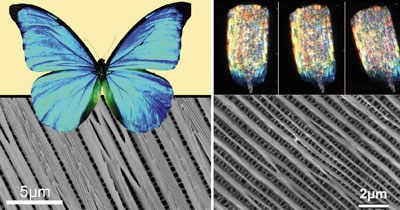Scientists in China have made zinc oxide replicas of single scales from butterfly wings to understand and exploit their optical properties for sensor and solar cell applications.

The Morpho menelaus butterfly with a magnified image of a wing scale (left) and zinc oxide scale replicas with a magnified image (right)
Butterfly wings are made up of chitin scales and their iridescent blue and green colours are generated by light and air travelling through the chitin. The way the scales are arranged dictates which colour is seen. Studying the wings’ properties to replicate the process could lead to the design of new photonic crystal structures for optical devices.
Until now, researchers have focused on making devices based on whole butterfly wings, but Jiajun Gu and Di Zhang from Shanghai Jiao Tong University and their team, believe that this misses important mechanisms and phenomena. This is because whole wings are covered by redundant parts, such as wing membranes, which could alter the optical properties of the wings’ scales.
To view the full Chemistry World article, please click here: A single scale tells more than a whole wing
Link to journal article
ZnO single butterfly wing scales: synthesis and spatial optical anisotropy
Yu Chen, Xining Zang, Jiajun Gu, Shenmin Zhu, Huilan Su, Di Zhang, Xiaobin Hu, Qinglei Liu, Wang Zhang and Dingxin Liu, J. Mater. Chem., 2011
DOI: 10.1039/c1jm10678c















